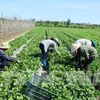Hà Nội’s cultivation reformed to add values
by ,http://vietnamnews.vn/society/464374/ha-nois-cultivation-reformed-to-add-values.html23 August 2018 Last updated at 07:59 AM


|
| Farmers in Hà Nội’s suburban district of Thường Tín grow organic tomatoes in greenhouses. — VNA/VNS Photo Đoàn Tùng |
HÀ NỘI — Hà Nội has been developing specialised cultivation areas to promote its farm products.
Since 2013, the total area for high quality rice in the city expanded from 52,000ha to 81,000ha, while total rice-growing area in general reduced from more than 204,350ha in 2013 to nearly 190,000ha now.
High quality rice was grown in the suburban districts of Mỹ Đức, Ứng Hòa, Phú Xuyên, Mê Linh, Thanh Oai, Chương Mỹ and Sóc Sơn. With high quality rice, farmers reportedly earn income 25-30 per cent higher than from conventional rice.
In the past five years, areas for vegetables, flowers and ornamental trees increased from around 31,700ha to 33,500ha, of which organic vegetable area made up 17,850 ha, 12 per cent more than in 2013.
Districts like Đông Anh, Phúc Thọ, Hoài Đức, Gia Lâm, Chương Mỹ and Đan Phượng have emerged with organic and safe vegetable cultivation, with each hectare of farm land able to generate VNĐ400-500 million (US$17,300-21,600) per year.
Nguyễn Mạnh Tùng, director of Lĩnh Nam Agriculture Service Co-operatives in Hoàng Mai District, said the company shifted to grow 40ha of safe vegetable five years ago and earned up to VNĐ500 million per hectare yearly while in the past, they earned about VNĐ110 million per hectare.
According to Hà Nội’s Agriculture and Rural Development Department, last year, the city used about 271ha for cultivation, 3.83 per cent less than the previous year. Cultivation generated VNĐ15.59 billion, 44.4 per cent of the city’s farming revenue.
Director of the department Chu Phú Mỹ said reforms in cultivation had brought results.
The city has boosted scientific and technology application in cultivation, for example, and now, there are 119ha of net houses used for vegetables and 110ha used for flowers, while water saving technology is used on 15ha of vegetables.
About 924.5ha of fruit growing area uses high-tech equipment, including high quality seeds on 634ha and tissue culture technology used for 372ha of bananas.
Mỹ said the municipal People’s Committee had mechanisms to encourage individuals and businesses to invest in agriculture.
“Hà Nội targets to make each hectare of cultivation land generate a 3 per cent increase of income yearly,” he said.
Shortcomings remain
Vice Director of the agriculture department Nguyễn Xuân Đại told the Kinh tế & Đô thị (Economic and Urban Affairs) newspaper that farming production in the city was still unstable and small-sized.
Vice Chairman of Thanh Oai District People’s Committee Bùi Văn Sáng said cultivation reforms required land consolidation, a shift to high quality species and new technology.
Sáng said farmers and local authorities need specific instructions to reform cultivation effectively.
Nguyễn Lân Hùng, general secretary of the Union of Biology Associations, said in cultivation reform, it was necessary to identify key crops and approach cultivation methods differently.
He meant farming products are commodities that must be produced sustainably and competitively.
“Hà Nội should focus on products with high quality and reduce prices to increase their competitiveness to farming products from other provinces and imported ones,” he said.
Hà Nội has more than 10 million residents with rising demand for agricultural products. However, the city’s production output meets only 60 per cent of demand, while many products are dependent on neighbouring localities.
Hà Nội’s rice output provides just 35 per cent of the city’s demand. Vegetable grown in the city satisfies 66 per cent of consumption demand. For the rest, the city must rely on supply from neighbouring provinces like Hưng Yên, Hà Nam, Bắc Ninh and Vĩnh Phúc. — VNS





